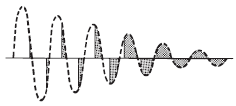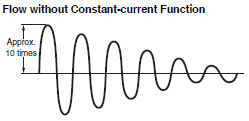Power Controllers
|
|
Features |
| Principles | Classifications |
| Engineering Data |
|
| Explanation of Terms | Troubleshooting |
Phase Control
Output is varied at half-phase intervals, which enables highly accurate temperature control.

Changes in the current output from the temperature controllers between 4 and 20 mA are used for analog control of the output power.
The more-detailed control resists disturbance better and results in less heat shock, which can also length the life of heaters.
The phase zero point must be detected to perform phase control. To detect the zero point, the phases must be the same. Phase difference may result in malfunctions. (The input signal and output value will not match.)
Duty Setting
As shown in the following graph, changes in the output can be adjusted with key operations or with an external variable resistor.
In the case of an electric oven, overshooting may result by using a heater with a capacity that is excessively high for the size of the oven. By adjusting the duty-setting variable resistor, the overshooting can be suppressed.
For example, if a duty of 60% is set for a 5-kW heater, a maximum of 3 kW will be input into the heater. Thus, it operates as a 3-kW heater.

Monitoring the Total Operation Time
The time that power is supplied to the G3PW is totaled and a warning is output if the preset time is exceeded.
This is useful for the management of maintenance according to the life of the load.
Soft-start
This function suppresses the inrush current that is caused when the load is turned ON, thus ensuring smooth starting of the load. The soft-start time is adjusted between 0 and 99.9s, thus enabling the heaters to withstand long use.
This function is especially effective for loads that involve high inrush current, such as halogen lamps.

Base-up
This function briefly keeps the output of the Power Controller turned ON after heating when the input signal is OFF. This is effective for a smooth start of equipment that is slow in initial heating operation.
Output Limit
The output range is limited by an upper limit and a lower limit.
This feature functions for the control input. It does not suppress inrush current.
Use the soft start to suppress inrush current.
Constant-current (for Constant-current Models Only)
This is a function that protects the heater and the system by automatically suppressing excessively large inrush current, such as with pure metal heaters.
As shown in the following figure, ten times the rated current flows when power is applied to pure metal heaters, for which molybdenum and tungsten are typical.
(This current cannot be fully suppressed by using a long softstart time.)

As shown in the following diagram, the constant-current circuit functions to automatically regulate to the current in response to the input signal. Inrush current is suppressed by reducing the ON phase.

Note: Protection is not provided in case of protection short circuit. Also use a quick-burning fuse.
Load Current Limit (for Constant-current Models Only)
The load current is measured by a built-in CT to adjust the output phase angle and suppress the load current.
The response time from measurement to suppression is 500 ms max. To suppress inrush current, use the soft start together with the load current limit.


